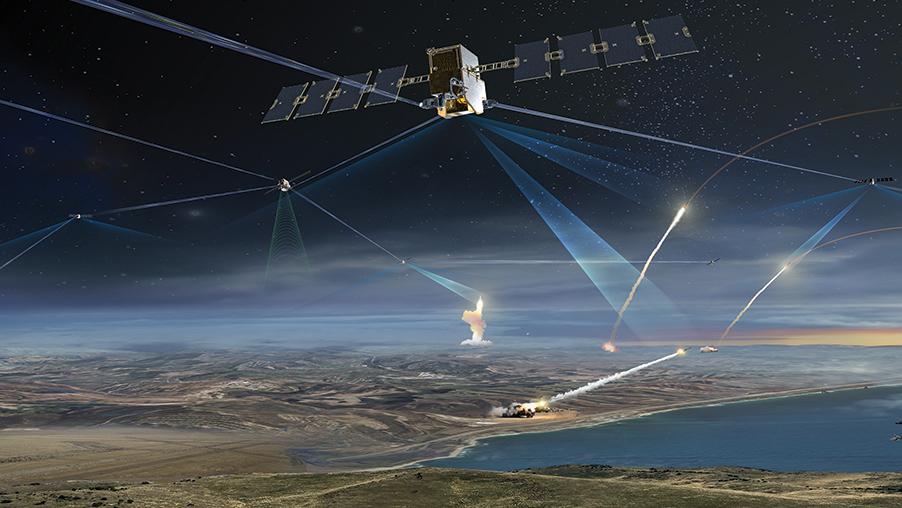
To counter China and Russia’s growing arsenal of hypersonic and ballistic missiles, the Space Development Agency is moving quickly to develop and launch a constellation of missile detection-and-tracking satellites. The outfit has awarded two prototype contracts worth about $1.32 billion to teams led by L3Harris Technologies and Northrop Grumman Strategic Space Systems for 28 Tranche 1 Tracking Layer satellites.
- Two companies signed up within four months of solicitation
- Space-based missile tracking is decades-old Pentagon goal
The constellation of overhead persistent infrared missile warning and tracking satellites intend to help the U.S. defend against ballistic and hypersonic missiles, the Space Development Agency (SDA) said on July 18.
Conventional U.S. overhead persistent infrared missile warning satellites were designed to spot ballistic missiles with a relatively straightforward and predictable trajectory. The Tranche 1 Tracking Layer satellites are designed to not only detect but track hypersonic and ballistic missiles. Boost-glide hypersonic missiles can maneuver unpredictably, making it difficult to calculate where the weapon will land.
“We will not only be able to do the old school mission of missile warning—detect the launch and predict the impact point—but we’ll be able to detect [a hypersonic missile] as it’s maneuvering and changing its impact point, and be able to send that down and be able to tell an interceptor exactly where that missile is headed,” SDA Director Derek Tournear says.
Due to the immediacy of the threat of hypersonic missiles, which are being developed and fielded by Russia and China, the SDA awarded contracts about four months after it published the Tranche 1 Tracking Layer satellite solicitation on March 17. Congress gave the SDA an additional $550 million in fiscal 2022 to accelerate development of the Tracking Layer, directing the agency to demonstrate the capability specifically in support of the U.S. Indo-Pacific Command.
The U.S. has relied on sea- or ground-based radar for missile tracking, but new threats require a new approach, says Tom Karako, director of the Missile Defense Project at the Center for Strategic and International Studies.
“Every single presidential administration since the Reagan administration has recognized the need for space-based sensors for missile defense,” he says. “And so far, it’s been almost exclusively done on paper in terms of the tracking problem. It’s high time to get after this.”
The SDA will take an initial stab at the problem with its Tracking Layer Tranche 0 constellation, consisting of eight prototype infrared missile warning and tracking satellites. In 2020, SpaceX and L3Harris were contracted to develop four satellites each for Tranche 0. The SDA plans to start launching those in September 2022 and March 2023.
That initial group of satellites is to demonstrate the capability of wide-field-of-view infrared missile warning and tracking from space, reducing risks for future satellite tranches, Tournear says. Tranche 1 is intended to improve on its predecessor satellites with technology enhancements, expanded coverage, increased integration and improved production efficiencies, the SDA says.
As part of the Tranche 1 program, L3Harris was awarded a prototype contract worth about $700 million for 14 satellites (about $50 million per satellite). Northrop Grumman Strategic Space Systems was awarded a contract worth $617 million for 14 satellites ($44 million per satellite). Both contracts cover all nonrecurring engineering for the satellites’ development, building and operational costs.
The overall Tranche 1 Tracking Layer program is worth about $2.5 billion, with the remainder of the total paying for space launches, ground operations and integrations and other costs.
The wide-field-of-view infrared satellites are scheduled to be put into orbit across four different launches, starting in April 2025, Tournear says. Each launch is planned to populate a different orbital plane. The low-Earth-orbit satellites are intended to fly at about 1,000 km (620 mi.) in altitude in polar orbits.
The Tracking Layer’s infrared sensors are designed to pick up on a hypersonic missile’s rocket booster during ascent, as well as the vehicle itself as it maneuvers and heats up in the atmosphere. Tracking data is shared with the SDA’s Transport Layer, a constellation of laser communications satellites.
“Our tracking satellites can see [a missile] instantaneously. Those tracking satellites detect it, they calculate the 2D track of where that missile is headed, and continually update that 2D track,” Tournear says. “They will take that 2D track and send that to the Transport Layer, which will send that down in hundreds of milliseconds to the ground station, where they will fuse all of those 2D tracks from multiple tracking satellites together.”
The combination of multiple tracks allows for a 3D track to be calculated.
“The 3D track is important because that could actually be used to send to an interceptor to be able to take out that hypersonic maneuvering vehicle,” Tournear says.
Maintaining fire-control quality data and not dropping the tracking mission will be critical for the program’s future, Karako says. “Make sure it retains connectivity to that missile defense-centric mission, so we don’t just admire the problem, but can actually do something about it.”
Karako adds that there is concern about the future of the Missile Defense Agency’s Hypersonic and Ballistic Tracking Space Sensor (HBTSS) prototype satellite, an infrared satellite with a smaller field of view but better sensitivity for fire control that is supposed to work in coordination with the Tracking Layer.
“The Missile Defense Agency is currently budgeted to continue to develop the sensor payload for HBTSS through fiscal 2023. But not after,” he says. “There could be a handoff [to another Pentagon entity]. We want to make sure that handoff doesn’t become a fumble in terms of the missile-defense-centric mission and the fire-control quality requirement, specifically.”
For its part, the SDA also wants to share tracking data with military personnel on the ground.
“They don’t have direct connectivity to all these Tracking Layer satellite data feeds, but they do have direct connectivity to the Transport Layer. The Transport Layer gives them connections via Link 16; it gives them connections via Ka-band downlinks and other bands.” Tournear says. “I can send that information down directly into [the] theater so that individuals can know whether they need to take cover or . . . whether they can start to engage other radar or weapon systems to intercept that hypersonic maneuvering vehicle.”
The SDA plans to add tranches continually to its Tracking Layer, with 54 satellites likely being launched as part of Tranche 2, Tournear says.
“You get in this continual replenish mode, because the satellites themselves have a five-year lifetime,” he says. “Every five years you’re replacing the whole constellation, so that means every year that’s 20% of your constellation [being replaced].”
Frequently adding and replacing satellites allows for the latest and greatest technology to be continually put in orbit. The acquisition structure of the Tracking Layer program is such that new entrants—or companies that lost prior competitions—have opportunities to offer the SDA better technology. Tournear has previously said that the SDA wants to avoid getting “stuck in a vendor-lock situation.”
“One of our goals was to create a market,” Tournear says. “If you lose on one solicitation, it doesn’t mean you’re out of the market for good. It just means that in another year or two, you’ll be able to bid again, and it will be an open competition.”


